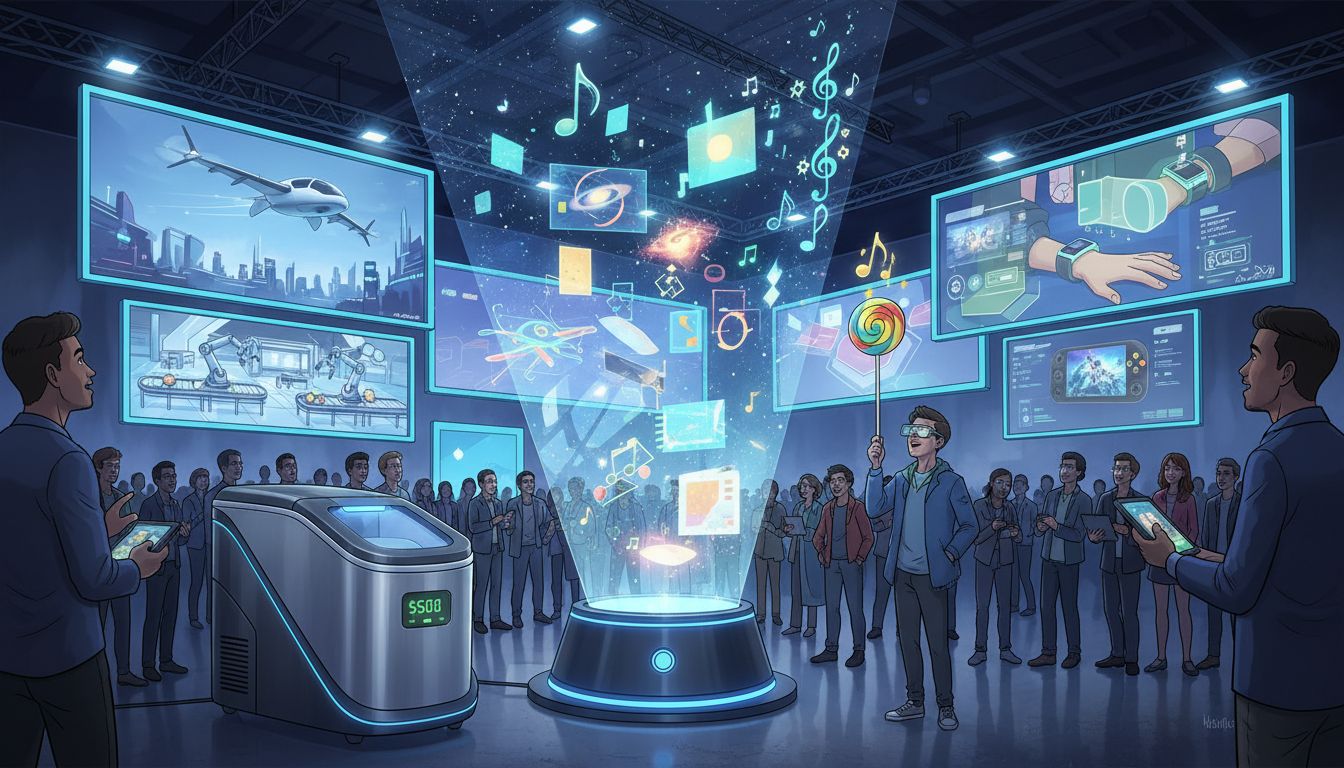Ever been stuck at a red light, tapping the steering wheel, while the lane next to you gets all the green lights? That’s frustration on wheels. Now imagine if someone could wave a magic wand and make those traffic lights sync up for smoother rides. Well, Google’s kind of done that with Google AI traffic light optimization.
We’ve all heard promises of tech making life easier, but this isn’t just talk; it’s happening right now in cities around us.
Think about what it means—less time idling at intersections and more open roads. Imagine cutting down on gas emissions without overhauling every car or road out there.
Catch your breath yet? Good. Let’s dive into how our daily drives are getting an upgrade—and why you should care.
Table Of Contents:
- Google’s Project Green Light and Its Impact on Urban Traffic
- The Role of AI in Optimizing Traffic Signals
- Reducing Stop-and-Go Traffic for Greener Cities
- The Environmental Stakes of Traffic Light Optimization
- How Google Maps Drives Change in Traffic Engineering
- The Role of AI in Optimizing Traffic Signals
- FAQs in Relation to Google Ai Traffic Light Optimization
- Conclusion
Google’s Project Green Light and Its Impact on Urban Traffic
Imagine you’re cruising down the road, your favorite tune playing, when suddenly you hit a red light. And then another. You can’t help but think, “There’s got to be a better way.” Well, Google heard that collective sigh from drivers everywhere and said: Challenge accepted.
The Birth of Project Green Light in Seattle’s Intersections
You know how Seattle is famous for its coffee? Now it might just become known for smoother car rides too. Thanks to Project Green Light, this city was the first to experience Google AI magic at intersections. It all started with traffic lights behaving more like knowledgeable locals than mindless robots—timing green lights just right so cars could glide through rather than screech to a halt.
We’ve seen urban areas transform with technology before, but what makes Project Green stand out is its seamless blend into existing infrastructure. There’s no waiting list for new gadgets; it takes what we already have and tunes it up like a mechanic breathing life into an old engine.
Global Reach: Expanding Beyond the U.S.
This isn’t just an American dream story though; after kicking off in Seattle, 13 cities worldwide decided they wanted in on these greener streets. By analyzing model traffic patterns unique to each locale—from Abu Dhabi’s bustling roads to Greater Manchester’s winding lanes—Google Maps driving trends are turning global gridlocks into open roads one intersection at a time.
If optimizing existing traffic light plans were music notes scattered across sheets of paper, Google AI would be the conductor orchestrating harmonious flows where once there were discordant jams—a symphony witnessed by thousands of maps users daily during their drives. With early numbers showing times higher efficiency at adjacent intersections, government agencies around the globe are tuning in attentively.
A Quick Fix with Lasting Benefits
Sometimes solutions don’t need rocket science—they just require smart tweaks here and there. Like recommending small changes that create waves throughout entire networks. Just ask any of those who’ve experienced implementing suggestions from analytics provider INRIX or driven through optimized routes thanks to Maps data. They’ll tell ya – sometimes little adjustments mean not hitting a single red light your whole ride home.
Traffic engineers aren’t the only ones benefiting either. Every driver gets a slice of the pie since reducing stop-and-go means less fuel burned—and fewer greenhouse gas emissions choking up our air. So while we’re saving a few minutes on our drives, we’re also doing our part for cleaner air and a healthier planet.
Google’s Project Green Light is turning red lights into green waves in cities like Seattle, using AI to sync traffic signals for smoother rides and cleaner air.
From local streets to global avenues, Google Maps data helps ease congestion, proving small changes can make big differences on the road.
The Role of AI in Optimizing Traffic Signals
From Data to Actionable Insights
Imagine a world where traffic signals are not just static timers but dynamic maestros, conducting the ebb and flow of city traffic with intelligence and foresight. That’s precisely what we’re seeing as AI technology gets behind the wheel to enhance existing traffic light plans. By harnessing maps data, artificial intelligence is transforming how we understand and manage urban movement.
In cities like Los Angeles, where car rides monthly tally up faster than movie premieres, every green light counts. But it’s not about luck; it’s about leveraging big data from sources like Google Maps driving trends. City engineers can now tap into this wealth of information for optimizing signal timings that keep pace with real-time road conditions.
This isn’t just theory—it’s practice on a grand scale. Take Abu Dhabi or Greater Manchester—places once ruled by red lights have seen early numbers showing smoother flows since adopting these insights-driven approaches to their intersections.
The Speed of Change in Traffic Management
Say goodbye to months-long studies and hello to near-instant updates—a hallmark benefit when you use AI technology for managing traffic signals. In the past, adjusting signal timings was like trying to solve a Rubik’s Cube blindfolded: time-consuming and often hit-or-miss.
But now? We’re talking turnaround times so fast they’d make your head spin—if only you weren’t enjoying such an unexpectedly smooth ride through town. Because yes indeed – today’s AI doesn’t drag its feet when implementing suggestions designed to improve traffic patterns across our ever-busy networks of roads.
No longer do drivers needlessly wait at red lights while adjacent intersections remain open roads devoid of cars—an inefficiency as outdated as floppy disks.
With every tweak made based on precise analytics provider INRIX’s rich datasets—or even feedback from everyday Google Maps users—the experience becomes more seamless for everyone involved.
And let me tell ya’, nothing quite compares with that moment when all green lights align perfectly before you—it feels almost like hitting jackpot after jackpot (minus any actual gambling).
This tech-savvy approach isn’t simply good news for impatient commuters either; think bigger picture here folks because it has massive implications down the line.
When properly synced up, thanks in part to advanced algorithms working around the clock, cities see significant improvements. This includes everything from cutting down on greenhouse gas emissions to creating safer streets with fewer accidents—a clear win for everyone involved.
AI is changing the game for traffic light control, turning red lights to green faster by using data from Google Maps and other sources. Cities are getting on board, making streets safer and commutes smoother with this smart tech.
Reducing Stop-and-Go Traffic for Greener Cities
Imagine cruising down the road, green lights all the way, like you’ve got an invisible VIP pass. That’s what Google is trying to do with its smart traffic light game plan.
The Emission Reduction Potential at Intersections
You know that annoying stop-and-go routine during your commute? It’s not just eating up your time; it’s puffing out more greenhouse gas than a dragon after a chili cook-off. But here’s some food for thought: smoothing out those starts and stops can slash emissions big time. Think about it—every time you hit the brakes, only to stomp on the gas moments later, you’re burning fuel like there’s no tomorrow.
By optimizing traffic signals using Project Green Light, we could see intersections acting less like bottlenecks and more like gateways to cleaner air. This isn’t pie-in-the-sky stuff either—the early numbers suggest we could cut stop-and-go emissions by up to 20%. Now that’s something worth accelerating toward.
Creating Smoother Rides and Cleaner Air
Riding through city streets shouldn’t feel like a game of red light, green light with a preschooler in charge. When AI takes over traffic patterns though, things get smoother faster than butter on hot toast. And who doesn’t love toast?
We’re talking fewer red lights staring you down because algorithms are busy crunching data from millions of car rides monthly—that means optimizing existing infrastructure without laying new asphalt or erecting extra signs.
This tech isn’t just good news for drivers tired of playing footsie with their brake pedals—it’s also helping us breathe easier by tackling urban greenhouse gases head-on (and nope, I’m not blowing smoke). In fact, studies show that improving flow can reduce vehicle emissions at intersections where idling has always been as popular as squirrels in a nut factory.
Fun Fact: You might think open roads lead cars to guzzle gas worse than teens raiding fridges—but slow-moving congestion is actually four times higher when it comes to fuel waste. Talk about motivation to let AI take the wheel and optimize traffic flow. With smarter routes, we can cut down on those frustrating jams and save a whole lot of gas in the process.
Google’s smart traffic lights could turn city drives into smooth sailing, slashing those pesky emissions by up to 20%. By letting AI handle the heavy lifting, we’re looking at fewer red lights and more green—all while saving gas and giving us cleaner air. Plus, did you know? Congestion chugs fuel four times as much as cruising does.
The Environmental Stakes of Traffic Light Optimization
Think about the last time you were stuck at a red light, engine idling, and that little voice in your head asked: “Isn’t there a better way?” Well, buckle up because Google’s Project Green Light is shifting gears on urban transportation. It’s not just about dodging the frustration of stop-and-go traffic; it’s also fighting against an invisible enemy – greenhouse gas emissions.
Intersection Emissions – A Target for Reduction
Road warriors know it all too well. The dance between green lights and red can feel like a plot to make sure you hit every single red light before reaching your destination. But here’s where Project Green Light steps into the spotlight. By optimizing existing traffic light plans with AI smarts, this initiative isn’t just keeping wheels rolling; it’s taking aim at those pesky intersection emissions that contribute significantly to urban greenhouse gas outputs.
We’re talking real numbers here: studies suggest optimized signal timing could cut delays by up to 40%, making them quite the game-changer for city dwellers. And less delay means cars spend less time spewing exhaust while waiting for their turn to go vroom. Think fewer tailpipe tales-of-woe and more open roads with blue skies overhead.
Cities are buzzing hives of vehicles zipping from point A to B, but they’re also hotspots for air pollution – especially at intersections where cars often idle or accelerate hard when lights change. That’s why reducing emissions at these critical junctures through smarter timing is key—like hitting two birds with one stone (but hey, let’s not hit any actual birds).
Sure enough, tweaking traffic signals can lead us down a greener path—a fact backed by environmentalists who tell us that transportation accounts for over 20% of Europe’s total CO2. So if we get this right? We could be looking at cities competing over who has slashed more carbon—not whose drivers have mastered the artful dodge around rush hour.
This mission extends beyond U.S borders as well. With tests in places like Abu Dhabi showing early promise—we see what looks like waves created on water—but instead of ripples across oceans—it’s smooth rides across asphalt causing smiles per gallon savings worldwide.
You might think setting up such tech would be akin to building Rome daily—yet Google Maps driving trends reveal otherwise. Adjusting signal phases based on maps data doesn’t need years or even months—it can happen faster than swapping out burnt-out bulbs atop our streetlights. By tapping into real-time traffic flow, we can tweak signals on the fly, ensuring smoother rides for everyone. This approach is not only smart but also surprisingly quick to implement.
Google’s Project Green Light is revving up city drives and tackling air pollution by optimizing traffic lights with AI. It’s all about less idling, more moving, and cutting down those nasty emissions that clog our skies.
With smart timing at intersections, we’re on track to slash delays by 40%, giving us cleaner air and smoother commutes. This tech could turn cities into eco-friendly racetracks where the prize is blue skies above.
No need for a long haul; Google Maps data makes these updates faster than changing a lightbulb. We’re shifting from stop-and-go to go-go-go while keeping our carbon footprint in check.
How Google Maps Drives Change in Traffic Engineering
Traffic lights are like the heartbeats of urban traffic, setting the rhythm for cars and pedestrians alike. But sometimes they’re more out-of-sync garage band than a smooth symphony orchestra. That’s where Google Maps steps up to conduct.
The Birth of Project Green Light in Seattle’s Intersections
In Seattle, green lights aren’t just signals—they’re part of an ambitious project aiming to make car rides as slick as the city’s famous fish market tosses. Google launched Project Green Light, tapping into AI smarts to analyze heaps of maps driving trends and optimize those pesky red lights that can turn open roads into parking lots.
Seattle’s intersections were first on the waiting list for this makeover, becoming test beds for data-driven decisions that could cut down on everyone’s least favorite activity—waiting at a red light when there’s no traffic coming from any other direction.
Global Reach: Expanding Beyond the U.S.
This isn’t just some local gig; we’re talking global tour. From Abu Dhabi to Greater Manchester, cities worldwide got their traffic patterns jazzed up with insights from one cool cat—Google Maps AI technology—and saw early numbers suggesting times higher efficiency at adjacent intersections. Now that’s music to our ears (and engines).
A Quick Fix with Lasting Benefits
You’d think tweaking existing infrastructure would be harder than convincing a toddler that bedtime is fun time but implementing a suggestion from Project Green might just be easier than finding your way around town without maps driving directions. And it comes with long-term perks too; improved traffic flow today means less stop-and-go tomorrow—a big win for reducing greenhouse gas emissions and making sure you get home in time for dinner while saving fuel along the way.
The Role of AI in Optimizing Traffic Signals
If traffic engineers had spirit animals, artificial intelligence would probably be theirs by now. With its ability to crunch through massive amounts of analytics provider INRIX data faster than you can say “green light,” AI is creating waves across road transportation networks without laying down so much as an inch of new asphalt.
From Data to Actionable Insights
Gone are the days spent squinting over complex charts trying to model traffic behaviors—at least if you have access to this tech-savvy tool belt. It’s called optimizing existing traffic signal plans using maps and users’ anonymous aggregated information, all churned through algorithms sharper than cheddar cheese at a state fair. This method streamlines the process of making roadways more efficient and less congested.
Google Maps is not just for directions anymore; it’s tuning traffic lights worldwide with Project Green Light. This AI-driven initiative in Seattle and beyond boosts intersection efficiency, slashing wait times and emissions—making our drives smoother than ever.
FAQs in Relation to Google Ai Traffic Light Optimization
Can Google AI help cities reduce traffic emissions?
Google AI can cut city traffic fumes by streamlining signals, making drives smoother with fewer stops and starts.
How is AI used in traffic lights?
AI crunches real-time data to tweak reds and greens, keeping cars rolling efficiently through crossroads.
How can AI reduce traffic?
By predicting jams and adjusting signal patterns, AI keeps the metal moving and brakes cooling.
What are the disadvantages of smart traffic lights?
The tech’s pricey up front. Plus it needs constant data flow—no input means no smarts at intersections.
Conclusion
So, Google AI traffic light optimization is more than just a concept; it’s a game-changer. It’s reshaping cityscapes and making drives smoother.
Cut down waiting times at red lights? Check. Less stop-and-go means happier drivers and healthier cities.
And the kicker—this tech can plug right into existing infrastructure. That’s efficiency without starting from scratch.
We’ve seen how small tweaks in timing can slash emissions big time. If that’s not a green flag for progress, what is?
Your takeaway? Those once annoying reds are turning eco-friendly greens—not just on the signal, but for our planet too.






